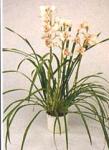|
|
CymbidiumFamily: Orchidaceae.
|
|
Cymbidium eburneum Lindl. |
 |
Genus of about 50 species of evergreen, epiphytic, lithophytic, or terrestrials orchids fromtemperate and tropical areas in India, China, Japan, S.E.Asia, and Australia. They have spherical to elongated pseudobulbs and 8-10 long, narrowly oval to linear, light to mid-green leaves. Flowers are borne in racemes from the bases, mainly in spring.
Large flowers collected into long, straight or slightly bent inflorecences. Blooming lasts about 2 months. In cuttings, the plant stays fresh a few weeks.
In the spring cymbidiums love to be moved out of doors as soon as the night temperature is going to stay in the mid 40’s or above and not come back in until a light frost, very light, in the fall. It is very helpful, if practical, to bring the cymbidiums in when frost is likely and then put them back out if it warms up. Very important for initiation of spikes is good temperature differential from night to day. This can be achieved in the summer by sprinkling the leaves in the late afternoon or early evening for evaporative cooling. If the night temperatures are too high, the spikes will not develop. Most Miniature Cymbidiums do best throughout the winter with a maximum night temperature of 55°F. While Standard Cymbidiums want a maximum night temperature of 50°F. |
 |
| Growing conditions |
Watering and misting |
Propagation |
| Grow in orchid potting mix for terrestial orchids. In the winter, keep in relatively cold temperature(around 50 degress), without a lot of water. In spring and summer, the plants need a pretty high temperature(60-65 degress), plentiful water, moist atmosphere, fresh air, and a lot of light (with slight shading on hot sunny days). When potting, it's important not to bury the base of the stem, but to leave it above the surface of the mix. |
Water moderately in summer, sparingly in winter. Mist once or twice a day. |
Divide in spring, or remove backbulbs and pot up after flowering. |
|
These materials are freely provided for instructional and educational purposes. Any duplication or publication of text or images herein for commercial gain without explicit written permission of the owner or photographer constitutes breach of trust and violation of copyright.
Copyright © Galka Okhapkina 1998-2025


